Originally announced as part of the Capcom five, five games that were planned to be GameCube exclusive, (although all but one stayed exclusive to the console) Viewtiful Joe made its way onto the purple gaming machine in the summer of 2003. The game was overseen by Hideki Kamiya, who would later go on to form Clover Studios and Platinum Games and produce critically acclaimed titles such as Okami and Bayonetta. When playing Viewtiful Joe his influence on the game is clear to see.
The game begins with the player character Joe attending a movie theatre with his significant other; Silvia, when suddenly a giant robot breaks through the cinema screen and grabs his lover, taking her into the world of Movieland. Joe immediately follows after her, and sets out on his quest to save her. The game doesn’t waste any time with getting to the gameplay, players can start kicking and punching enemies within a couple of minutes of starting the game. Unlike the rather cutscene heavy Bayonetta and Metal Gear Rising, the story isn’t given a huge amount of time in this game.
The story itself is a standard cliché ridden affair about the guy rescuing the girl, it has been done hundreds of time before, not just in gaming but in all types of fictional media. I have no problem with this though, as the game’s narrative is just an excuse to set up the crazy events that follow, and in my opinion it’s good that it’s simple and doesn’t intrude too much upon the game itself.
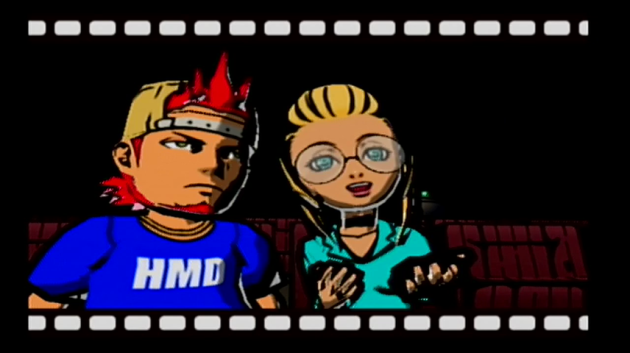
Silvia can be unlocked as a playable character upon completing the game on the Adults difficulty setting.
Once Joe enters Movieland the player is shown how to perform the basics of combat, and is then set on their way. Initially Joe doesn’t have any superpowers. This changes a couple of minutes into the first level, when the player comes up against famous movie character, Captain Blue. After defeating Blue, he hands Joe a V-Watch, a device capable of transforming the movie buff into a superhero upon saying the magic word, “henshin.” Of course, in typical Hollywood fashion Joe decides that he doesn’t want to stick to the script and adds his own flair by instead coining his famous catchphrase, “Henshin-a-go-go-baby!”
The player is then introduced to the first VFX (viewtiful effects) special move. The move “Slow”, activated by pressing the left shoulder button, grants the player the ability to slow down time, allowing them to dodge bullets, enemy attacks and other projectiles, it can also be used to score some critical hits. “Slow”, like all the other VFX moves can also be used to solve puzzles.
There are three VFX moves in total, the second move “Mach Speed” allows Joe to move faster, creating multiple versions of himself for easy crowd control, and the last (and most strange) special move is “Zoom”. With an upwards press of the C-Stick, the camera zooms in on Joe, who can then punch or kick enemies for huge damage. I can’t think of another game in which a character has a special power which is essentially a close-up of themselves, and it shows how much the team designing the game were thinking outside of the box.
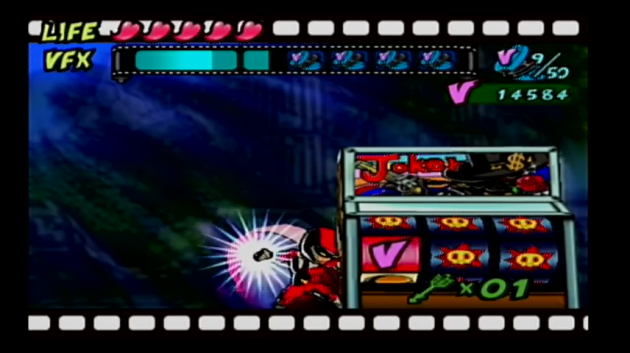
This puzzle, introduced shortly after gaining the “slow” move, requires the player to slow down time and then hit the slot machine in order to match the three required symbols. Although it’s a clever mechanic, this puzzle in some shape or form appears in nearly all of the game’s chapters, and like the rest of the Viewtiful Joe’s puzzles, it becomes quickly overused.
VFX moves can be combined and used in unison with one another, so for instance a player could zoom-in on Joe and then slow down time to inflict a lot of pain on an enemy. Although as previously mentioned, there are only three VFX moves within the game, the fact that they can be used with one another means there is a lot of depth within the combat.
These moves can only be used when the player has some of their VFX meter full, whilst using any of the VFX moves the meter will begin to drain. It’s a bit like the stamina bar featured in Dark Souls, players have to keep a careful watch over their VFX meter and can’t simply spam the special moves, if Joe’s VFX meter becomes completely depleted then he will transform back into his regular self until a section of the meter is refilled. This leaves Joe vulnerable to attack as none of his VFX moves can be used when in this state and he also loses the ability to double jump, putting him at a clear disadvantage.
Scattered around each of the game’s seven chapters are film reels. When Joe collects fifty of these the length of the VFX bar increases. Unfortunately there is no permanent way to upgrade the VFX bar and it’s length is reset every chapter, meaning that when starting a new level the player must search around for film reels to increase the VFX meter again. This can become quite tedious when playing through a level more than once.
The player has to make sure they collect as many film reels as they can during each level, if they don’t they’ll have a much harder time fighting the end of level boss.
Extra moves and techniques can also be purchased via the in-game shop, adding yet more layers to the combat, “Viewtifuls” (the game’s currency) are acquired by defeating enemies, or sometimes found hidden in the environment. Some of the techniques on offer will be recognisable to those who have played some of Hideki Kamiya’s other games. For example, the “Ukemi” technique is also found within The Wonderful 101, and has the same effect when used.
Graphically the game still holds up well today, much more so than other games released around the same time. It is to be expected due to the cel-shaded visuals that were used, as generally games that incorporate this visual style stand the test of time better than games that don’t, (The Legend of Zelda: The Windwaker, Killer 7 and Jet Set Radio are other good examples of cel-shaded games that still look great today) but it’s still impressive nonetheless.
The gameplay plays out like old-school beat ’em ups. Joe progresses through each level by travelling left or right, fighting through hordes of enemies. He will usually encounter a mini-boss of sorts half way through a chapter at which point the player can usually save their game and visit the shop. Then, in the second half of a chapter, Joe fights his way through hordes of enemies once again, until he comes face to face with a much tougher end of level boss. After defeating the boss the player can once again save their game and visit the in-game shop, before attempting the next level.
The yellow skull within the red star is used to indicate what attack an enemy is about to perform. If the skull is on the floor then the enemy is about to unleash a low-attack, which can be dodged by pressing up on the analog stick, on the other hand if the skull is positioned around Joe’s head height, then the attack can be dodged by pressing down.
Like the games of old, Viewtiful Joe is a cruel game. Going back to the game for the first time in at least ten years, I remembered that I never did complete the game when I originally owned it. The game features two default difficulty settings: Kids and Adults. After completing the first few levels on Adults without too much trouble, I began to wonder why I never did finish it all those years ago. A couple of levels later though, I began to understand why.
This game is hard, and I say this as someone who enjoys games that are generally considered difficult, such as Dark Souls and Super Meat Boy. The problem with Viewtiful Joe is that it starts off deceptively easy, and then after the halfway stage becomes a different game entirely.
Chapter five was a particular point when I believed things just started to get a bit too ridiculous. At the beginning of the level Joe has to fight through a horde of enemies, he then has a mini-boss battle against a tank, (which granted is easy is you use slow-mo and hit the tank’s bullets back at itself), after this Joe fights against another boss in the form of a harrier. He then has to traverse through a lava infested sewer system and if Joe falls into the lava (which I did a lot) he loses a decent sized amount of health. He then has to fight through another horde of enemies once exiting the sewer system, before fighting the harrier boss again. It isn’t over yet though, after defeating the harrier boss for the second time, Joe fights another tank on a bridge, and then proceeds to battle against another harrier.
When I was faced with the third harrier boss, I suddenly turned into John McEnroe as I shouted out loud, “Really? You can’t be serious!” I’m all for difficult games, but at this point it felt like Capcom had not just resorted to throwing the kitchen sink at the player, but instead decided to throw the entire house at them. In addition that was only part one of the chapter. No wonder I never completed the game when I first played it.
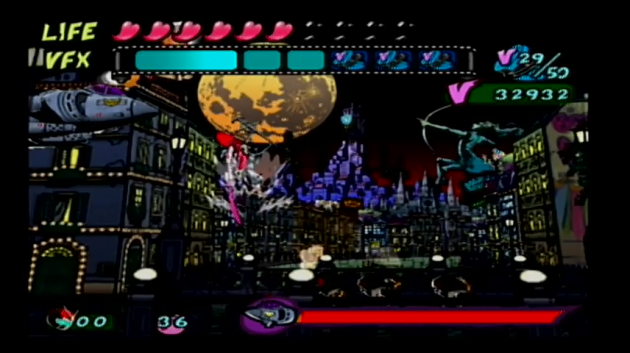
Why Capcom, why won’t it just end?
Things get even worse in chapter six, The Magnificent 5, when the player has to fight through a boss rush mode containing the four end of level bosses featured in the first four chapters of the game. I have two major problems with this section of the game. Firstly, it’s quite boring. You will die, a lot, during this section and will have to replay it a lot, but the easiest way to kill most of the bosses is to use the “zoom” and “slow “moves at the same time and then punch to deliver the most damage. Doing this over and over again gets tedious. In addition each boss has about 6 or 7 full bars of life that need to be depleted. Spending nearly half an hour getting to the final boss; Another Joe, and then dying is just frustrating.
Secondly, the save system within the game is awful and seems to be random in where the player can save their progress. Usually the game allows the player to save their progress after completing the first part of a chapter and just before fighting the end of level boss, but this isn’t always the case. Thankfully, the player is always giving the option to save their game after finishing a chapter.
Before fighting Hulk Davidson, the boss of chapter two, the player is given the chance to visit the store before fighting him, but isn’t able to save their game. Although if the player loses all their lives they can resume the game just before the fight, if they decide that they have had enough and want to stop playing, when they come back to the game they will have to start again from the beginning of the second half of the chapter, meaning they will have to fight through the second section of the level again until they reach the boss.
The save system during The Magnificent 5 section is even worse. Say you’ve somehow managed to fight through all the four bosses and have made it to the halfway stage in the chapter, well guess what, you can’t save your progress. Like the example above when the player is about to fight Hulk Davidson for the first time, the player is given the option to visit the store but not save their game.
Seeing as it can take hours to finally overcome this boss rush section, it would be nice to be able to save the game. In addition after completing this section the player has to fight against Fire Leo in the second half of the chapter, who is described by most as the toughest boss in the game. Imagine spending hours finally getting to this point, and then realising that at that moment in time you just can’t beat Fire Leo, but knowing that if you do quit the game, you’ll have to defeat the previous four bosses all over again. I’ve looked at many online forums and articles about Viewtiful Joe, and it seems as that this is the point that most players decided to give up on the game.
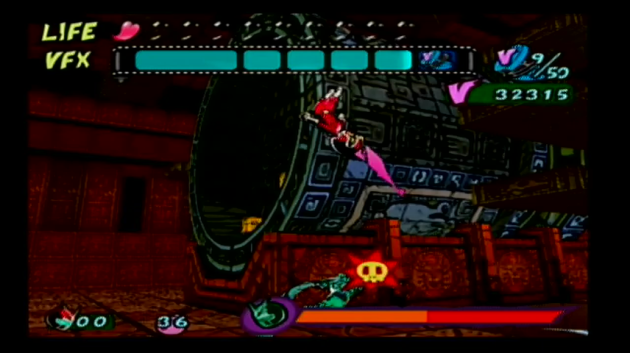
I can reach the final boss of the first part of the magnificent 5, Another Joe, but this is the closest I’ve come to defeating him. I went into this section with five lives and still couldn’t do it.
I have to say for the time being, I will be joining those who decided to throw in the towel. I’m too stubborn to start the game again on the easier kids difficulty setting (which I’m told is still a challenge), plus the only way to unlock Silvia and carry over saved game progress onto a new playthrough is by completing the game on the adults difficulty. My intention was to finish this game before writing about it, but the truth is it could take me another couple of weeks to complete the last two chapters.
The reason why I’ve given up for now is because I’m just not having fun with this game any more. It’s due to the game’s bi-polar save system and the mundane nature of the magnificent 5, more so than the actual difficulty of that section. Like I said, I don’t mind difficult games, but to me this just isn’t fun. Maybe in a few weeks I’ll come back and defeat this section of the game.
This article is a bit similar to the structure of Viewtiful Joe, it started of light-hearted as I began by praising the game and talking about its good points, before without warning changing into something else entirely, as I moved onto pointing out its flaws in the second half of this post. The truth is I just can’t make up my mind about this game, it’s fantastic but frustrating, tedious but exciting. Viewtiful Joe is a gaming paradox.
For every brilliant gameplay design in Viewtiful Joe, there is something else holding it back. The game is beautiful, the combat is intuitive and the game itself is a wonderful concept, but it’s held back by a terrible save system, and crazy difficulty spikes. I put in nearly 70 hours completing Dark Souls and when I completed the game it felt worth it. At the moment putting more hours into Viewtiful Joe just doesn’t feel worth it at all.

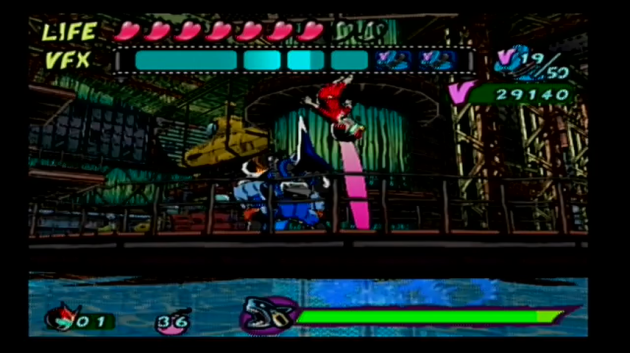
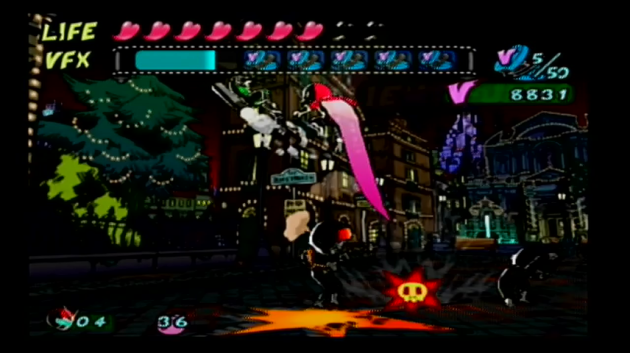
Yeah, the saving system is awful; the game by itself is already hard enough, Capcom did not need to make things harder by implementing cheap save points.
I played the game on Kids difficulty because I suck at beat ’em ups and I had read about how frustratingly difficult it can get on the Adults mode.
LikeLiked by 1 person
Exactly! I really don’t know why they decided to sometimes have save points before bosses and sometimes not.
Oh cool, did you manage to finish the game?
I don’t usually mind difficult games. If the difficulty is implemented in the right way I believe it can sometimes work in a games favour, but Viewtiful Joe just made me want to throw my controller on the floor!
LikeLike
I did finish it!
And I agree, there is thin line between difficulty and frustration, and it is important to stay on the right side of it. Badly placed save points that end up punishing a player by forcing him to replay a large portion of the level are an artificial and poor source of difficulty.
Difficulty should derive exclusively from level-design or the toughness of enemies, not from things like save points.
LikeLike
This always seemed like a love it or hate it kind of game to me. Mind you I’ve never played it myself so it was nice to get a decent description of what playing it is like. Viewtiful Joe got a sequel correct? OWnder if they cleared up the game’s issues in it…
LikeLiked by 1 person
It does seem to split opinion, I still think it’s a very good game though, just extremely frustrating at times.
Yes, it got a sequel. I haven’t played it, but I would like to in the future. Hopefully is fixes some of the issues, otherwise I’ll probably have a mixed experience with that as well!
LikeLiked by 1 person